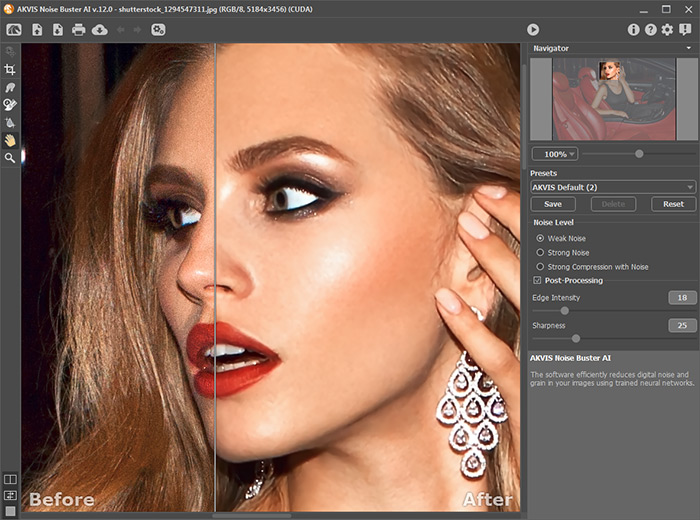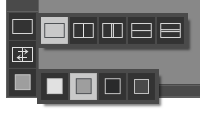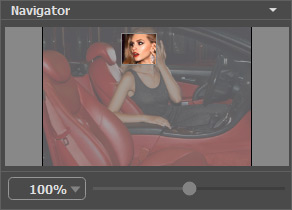Workspace
AKVIS Noise Buster AI can work independently as a standalone program as well as a plug-in to a photo editor.
Standalone is an independent program. You can run it in the usual way.
Plugin is an add-on for graphics editors, for example for Photoshop, AliveColors, and other compatible programs. To call the plugin, select it from filters of your image editing program.
The AKVIS Noise Buster AI workspace looks like this:

Features of the Workspace:
Most of the AKVIS Noise Buster AI workspace is taken by the Image Window with two tabs: Before and After. In the Before tab, the original image is shown, while in the After tab you can see the result. You can compare the original image with the result by clicking any point of the image.
Note that when the After tab is pressed, it starts image processing with the current settings.
You can select how Image Window and Before/After tabs will be shown by adjusting the View Modes in the bottom part of the left panel.

In the upper part of the window, you can see the Control Panel.
- The button
 opens the home page of AKVIS Noise Buster AI.
opens the home page of AKVIS Noise Buster AI.
- The button
 (only in the standalone version) allows opening an image for processing.
(only in the standalone version) allows opening an image for processing.
Right-click this button to display the list of recent files. You can change the number of recent documents in the program's Preferences.
- The button
 (only in the standalone version) allows saving a resulting image to the disk.
(only in the standalone version) allows saving a resulting image to the disk.
- The button
 (only in the standalone version) allows printing the image.
(only in the standalone version) allows printing the image.
- The button
 (only in the standalone version) opens the Batch Processing dialog to automatically process a series of images.
(only in the standalone version) opens the Batch Processing dialog to automatically process a series of images.
- The button
 cancels the last action. If it is pressed multiple times, it will cancel several previous actions. This can also be activated with the keyboard, by pressing Ctrl+Z on Windows, ⌘+Z on Mac.
cancels the last action. If it is pressed multiple times, it will cancel several previous actions. This can also be activated with the keyboard, by pressing Ctrl+Z on Windows, ⌘+Z on Mac.
- The button
 restores an action cancelled by
restores an action cancelled by  .
.
- The button
 launches filtration of the entire image. Before you press this button the filtration result is shown only in the preview area.
launches filtration of the entire image. Before you press this button the filtration result is shown only in the preview area.
- The button
 (only in the plugin version) allows applying the filtration result to the image and closes the AKVIS Noise Buster AI window.
(only in the plugin version) allows applying the filtration result to the image and closes the AKVIS Noise Buster AI window.
- The button
 shows information about the program: version, license, etc.
shows information about the program: version, license, etc.
- The button
 is designed to call the Help files of the program.
is designed to call the Help files of the program.
- The button
 calls the Preferences dialog box for changing the program's options.
calls the Preferences dialog box for changing the program's options.
- The button
 opens a window showing the latest news about Noise Buster AI.
opens a window showing the latest news about Noise Buster AI.
To the left of the main window there is the Toolbar. The tools' parameters are shown in a pop-up box after right-clicking in the image.
Pre-Processing Tools (in the Before tab):
- The button
 switches on/off the Quick Preview area (more about the preview).
switches on/off the Quick Preview area (more about the preview).
- The button
 (only in the standalone version) activates the Crop tool which allows cutting off unwanted areas in the image.
(only in the standalone version) activates the Crop tool which allows cutting off unwanted areas in the image.
Post-Processing Tools (available in the After tab):
Attention! If you switch to the Before tab and re-run the image processing  , the changes made with these tools will be lost!
, the changes made with these tools will be lost!
- The button
 activates the Smudge tool which helps to refine the image by removing unwanted irregularities.
activates the Smudge tool which helps to refine the image by removing unwanted irregularities.
- The button
 activates the History Brush tool which restores areas to their original state.
activates the History Brush tool which restores areas to their original state.
- The button
 activates the Smart Blur tool which smooths out grain and noise while preserving outlines and details. It is available only under Home Deluxe and Business licenses.
activates the Smart Blur tool which smooths out grain and noise while preserving outlines and details. It is available only under Home Deluxe and Business licenses.
The tools' parameters:
- Size affects the tool's diameter.
- Hardness changes the blurriness of the edges of the tool. The lower the value, the more blurry the tool's edges are.
- Strength affects the force of the tool applied to the image.
Additional Tools:
- The button
 activates the Hand tool, which allows you to scroll the image when it does not fit within the Image Window at the desired scale. To use it, click the button, bring the cursor over the image, and while keeping the left mouse button pressed move in the desired direction.
activates the Hand tool, which allows you to scroll the image when it does not fit within the Image Window at the desired scale. To use it, click the button, bring the cursor over the image, and while keeping the left mouse button pressed move in the desired direction.
Double-clicking the tool's icon in the Toolbar makes the image fit the Image Window.
in the Toolbar makes the image fit the Image Window.
- The button
 activates the Zoom tool, which changes the image's scale. To zoom in, left click in the image. To zoom out, right click in the image. Press Z to quickly access the tool.
activates the Zoom tool, which changes the image's scale. To zoom in, left click in the image. To zoom out, right click in the image. Press Z to quickly access the tool.
Double-clicking the tool's icon in the Toolbar makes the image scale to 100% (actual size).
in the Toolbar makes the image scale to 100% (actual size).
Moving and scaling the image is done in the Navigator. In the Navigator, you can see the reduced copy of the image. A frame surrounds the part of the image visible in the Image Window; the area outside of the frame will be shaded. The frame can be dragged to display a different part of the image. To move the frame, bring the cursor inside the frame, press the left mouse button, and while keeping it pressed, drag the cursor.

Additionally, you can move the image in the Image Window with the scroll bars or by holding down the space bar, then holding down the left mouse button while moving the mouse. Use the scroll wheel of the mouse to move the image up/down, by keeping the Ctrl (⌘ in Mac) key pressed – to the left/to the right, by keeping the Alt (Option in Mac) key pressed − scale the image. Right-click the scroll bar to activate the quick navigation menu.
Use the slider to scale the image in the main window. When you move the slider to the right, the image scale increases. When you move the slider to the left, the image scale reduces.
You can also change the image scale by entering a new coefficient into the scale field. Frequently used scale coefficients can be found in a fall-down menu.
You can use hot-keys to change the image scale + and Ctrl++ on Windows, ⌘++ on Mac to scale up the image, and - and Ctrl+- on Windows, ⌘+- on Mac to scale down the image.
Under the Navigator, in the Settings Panel, you can choose a preset in the Presets field and adjust the noise reduction parameters.
Under the settings, you can see Hints for the parameters and buttons when you hover over them with the cursor. You can choose where the hints will be shown or hide them in the Preferences.
